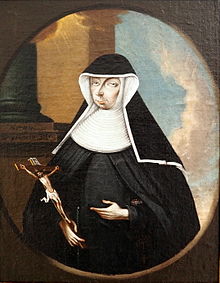Matron

The head of a sisterhood is generally referred to as a superior . In the ecclesiastical field, the head of a monastic community or religious community ( convent ) is referred to as a superior (also superior ). Superiors of independent monasteries can also be abbesses or prioresses . In the social , charitable and diaconal area, sororities, women's associations and social institutions of the most varied kinds, both secular and ecclesiastical, have traditionally also been headed by superiors, for example the nursing service of a hospital or the education of a girls' boarding school .
Roman Catholic Church
Through the vow of obedience , nuns and nuns undertake to follow the instructions of their rightful superior in everything that concerns the life of the community, taking into account the law of the Church and the proper law of their religious institute . The superior is required to regard her office as a service to the community, the unity of which she must protect, and to encourage and inspire the sisters to lead an exemplary religious life through her example and the use of her authority. The superiors of independent monasteries and abbeys, like provincial and general superiors of other orders, belong to the higher order superiors .
The salutation of a superior is often “Mother Superior” or (out of date) also “Venerable Mother”, in the case of higher superior also “Most Venerable Mother” or “Most Venerable Mother”. Nowadays the salutation “mother” or “sister” (abbreviated “M.” and “Sr.”) is used in connection with the religious name . In the case of abbesses, general superiors or prior general women, the address "Ms." is also possible in writing, for example "Revered Ms. Abbess" (without naming names).
Protestant church
The deaconess communities of the Kaiserswerth tradition initiated by Theodor Fliedner , whose members serve in a binding community of life, faith and sisters, are led by superiors.
Other evangelical sororities such as the Diakonieverein Berlin-Zehlendorf are headed by district superiors and a board superior. The salutation is "Frau Oberin", usually in connection with the surname.
Secular organizations
The total of 31 German DRK sororities are each headed by a superior. The umbrella organization "Association of Sisterhoods of the German Red Cross" is headed by a Superior General .
When the NS sisterhood was founded , the concept of the order played a role, so that the leaders of the sisterhood were called superiors. At its head was the Superior General, who was appointed by the head of the National Socialist People's Welfare Office. During the war effort, the various management levels were hierarchically divided into head nurse , army or field superior and superior general.
Web links
swell
- ^ Evangelischer Diakonieverein Berlin-Zehlendorf eV: We about us. How we are organized. Retrieved August 13, 2016
- ↑ Kathrin Kompisch: Perpetrators. Women under National Socialism. Böhlau Verlag, Cologne u. Weimar 2008, p. 116
- ↑ Birgit Breiding: The Brown Sisters. Ideology - structure - function of a nationalist elite (= contributions to economic and social history , vol. 85). Franz Steiner Verlag, Stuttgart 1998, pp. 36-74
